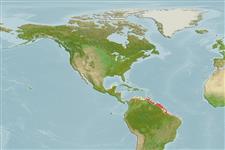Common names from other countries
>
Eupercaria/misc (Various families in series Eupercaria) >
Sciaenidae (Drums or croakers)
Etymology: Lonchurus: Greek, logche = lance + Greek, oura = tail (Ref. 45335).
Environment: milieu / climate zone / depth range / distribution range
Ecologia
marino; salmastro demersale; distribuzione batimetrica ? - 25 m (Ref. 5217). Tropical
Western Atlantic: Colombia (Ref. 5217) to Brazil.
Size / Peso / Age
Maturity: Lm ? range ? - ? cm
Max length : 32.0 cm TL maschio/sesso non determinato; (Ref. 9626); common length : 27.0 cm TL maschio/sesso non determinato; (Ref. 3702)
Spine dorsali (totale) : 11; Raggi dorsali molli (totale) : 32 - 34; Spine anali: 2; Raggi anali molli: 7. Colour dark greyish above, yellowish to pale below. Pectoral fins long and jet black. Tips of pelvic and anal fins dark. Inside of gill cover black. Eye small, about 8 to 9 times in head length. Mouth small, inferior, enclosed under snout. Chin with 5 pores and many barbels, 3 to 4 pairs in a tuft around median mental pore, 15 or 16 pairs along median edges of lower jaws and subopercles. Pectoral fins greatly enlarged, extending beyond anal-fin base. Gas bladder narrow, about equal to head length, bearing anteriorly 2 pairs of appendages, anterior pair short and horn-like, lateral pair long, tube-like, extends to posterior end of gas bladder (Ref 51721).
Found over mud or mud-sand bottoms of estuaries and adjacent areas (Ref. 5217). Feeds on bottom-dwelling organisms, mainly worms. Marketed fresh and salted.
Life cycle and mating behavior
Maturities | Riproduzione | Spawnings | Egg(s) | Fecundities | Larve
Chao, L.N., 1978. Sciaenidae. In W. Fischer (ed.) FAO species identification sheets for fishery purposes. West Atlantic (Fishing Area 31). Volume 4. FAO, Rome. (Ref. 3702)
IUCN Red List Status (Ref. 130435)
CITES (Ref. 128078)
Not Evaluated
Threat to humans
Harmless
Human uses
Pesca: scarso interesse commerciale
Strumenti
Special reports
Download XML
Fonti Internet
Estimates based on models
Preferred temperature (Ref.
115969): 27 - 28.3, mean 27.5 (based on 362 cells).
Phylogenetic diversity index (Ref.
82804): PD
50 = 0.7500 [Uniqueness, from 0.5 = low to 2.0 = high].
Bayesian length-weight: a=0.00851 (0.00413 - 0.01752), b=3.08 (2.91 - 3.25), in cm Total Length, based on LWR estimates for this (Sub)family-body shape (Ref.
93245).
Trophic level (Ref.
69278): 3.3 ±0.31 se; based on food items.
Resilienza (Ref.
120179): Alto, tempo minimo di raddoppiamento della popolazione meno di 15 mesi (Preliminary K or Fecundity.).
Fishing Vulnerability (Ref.
59153): Low vulnerability (22 of 100).
